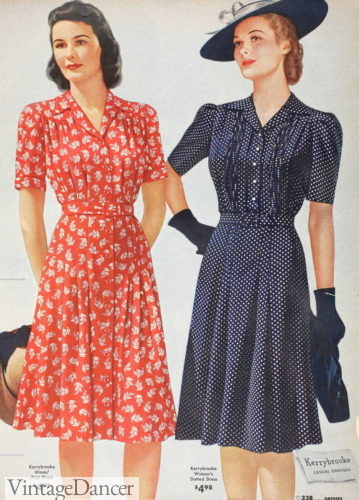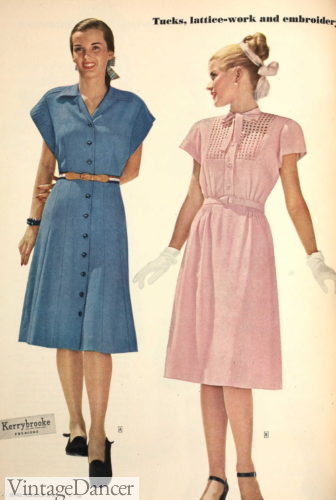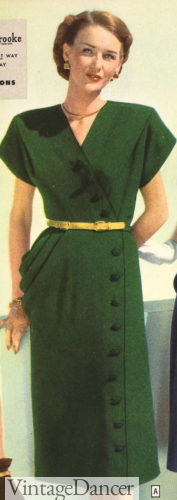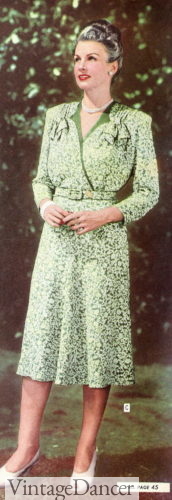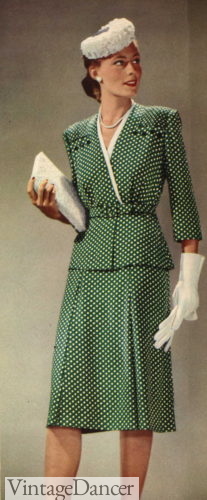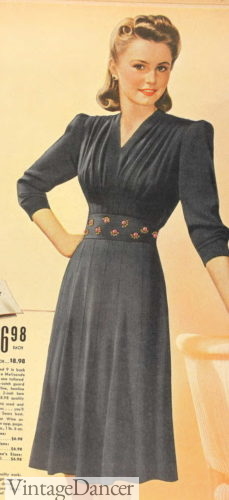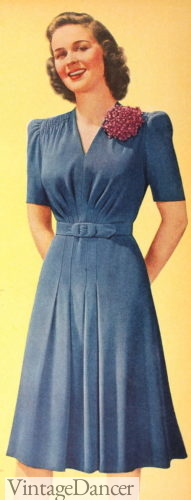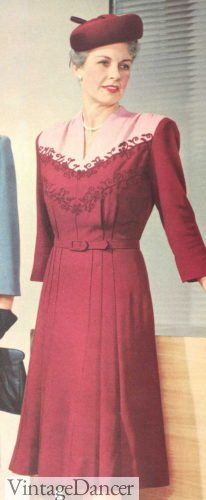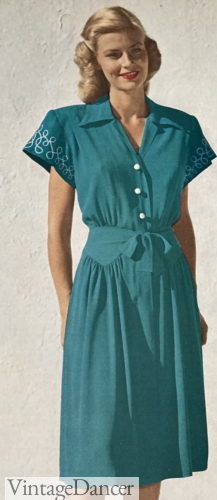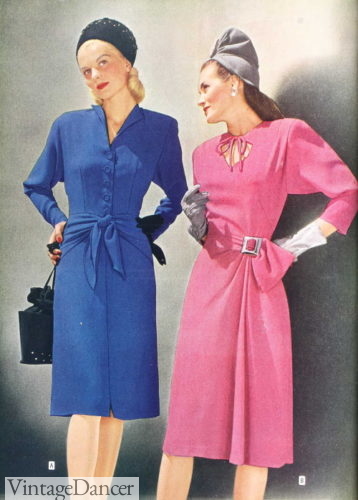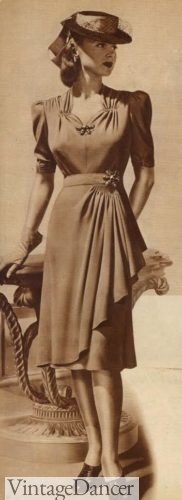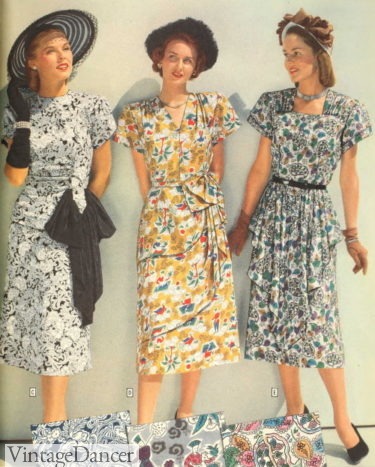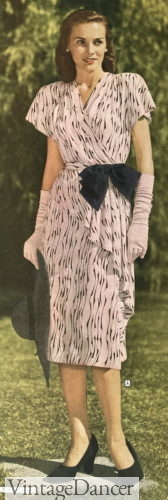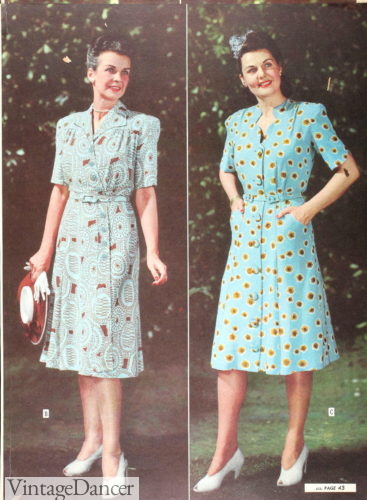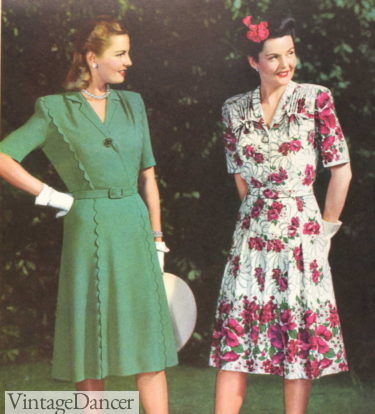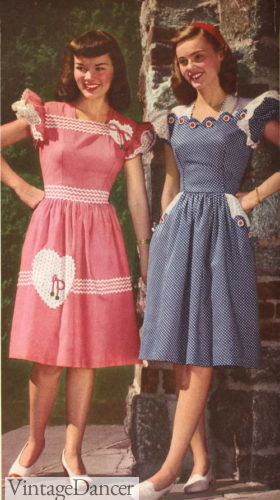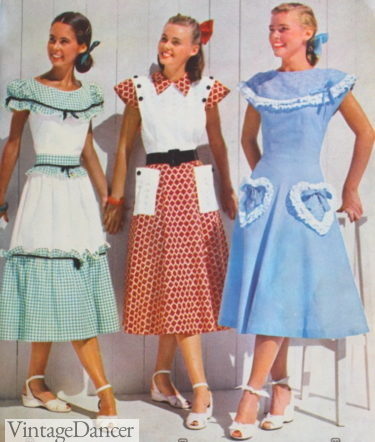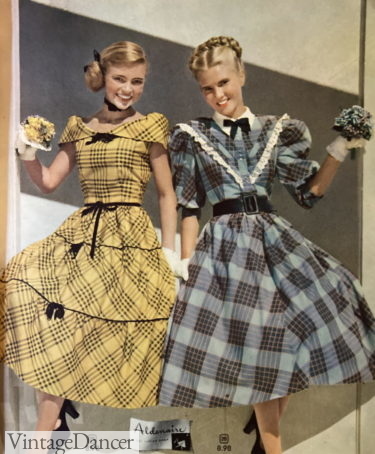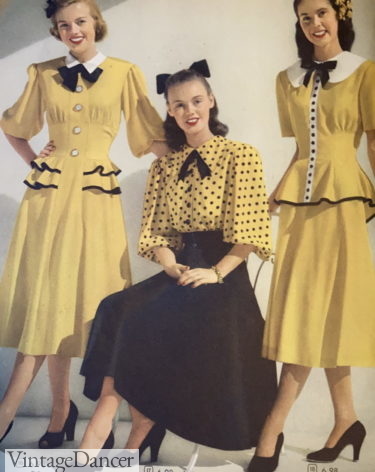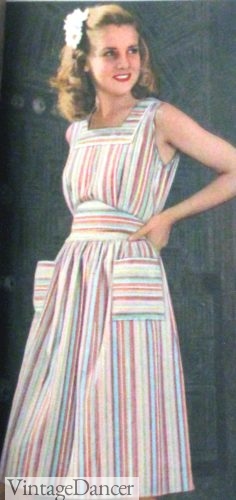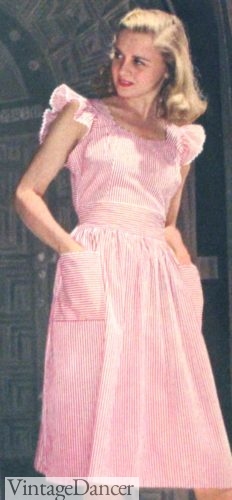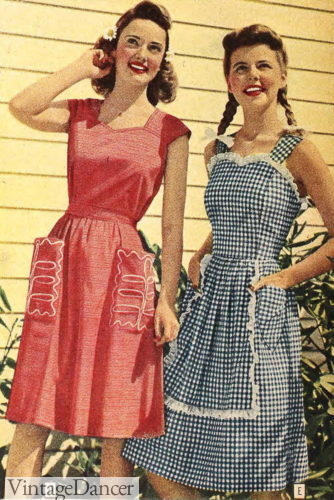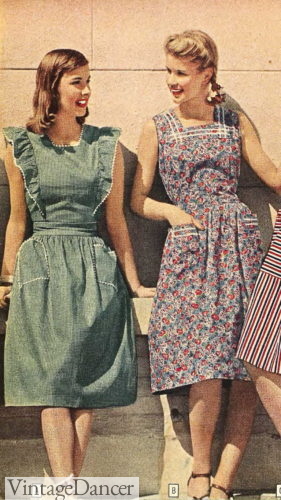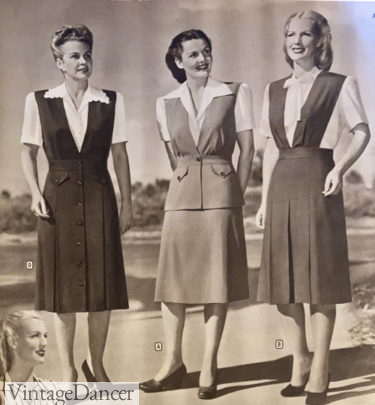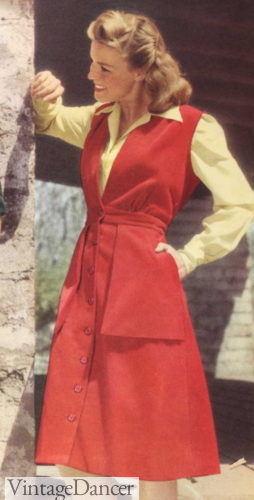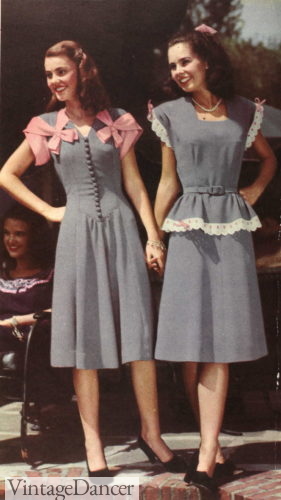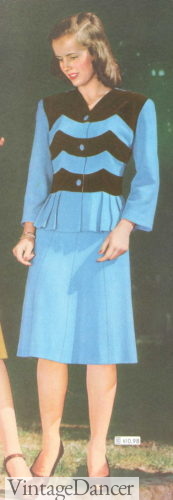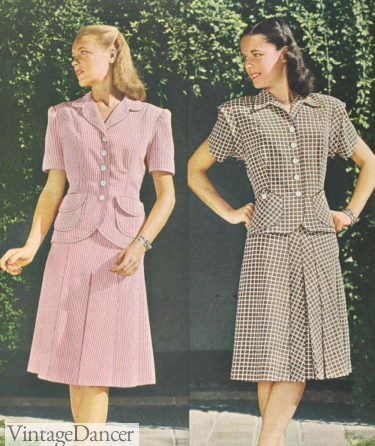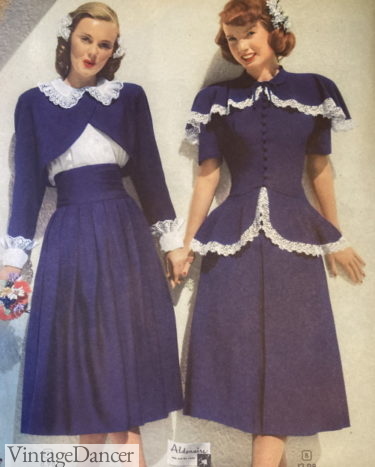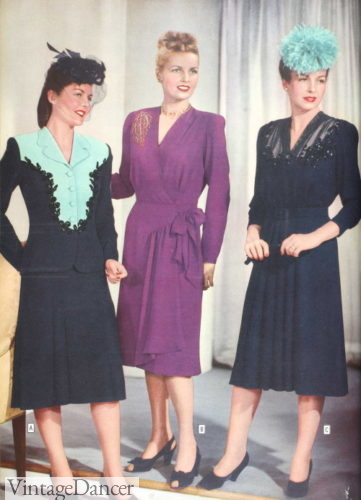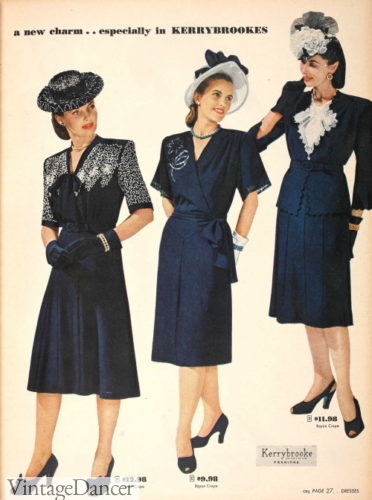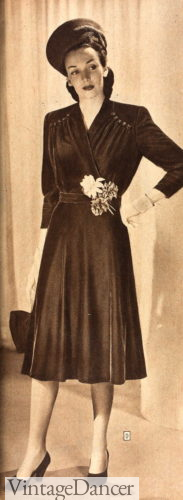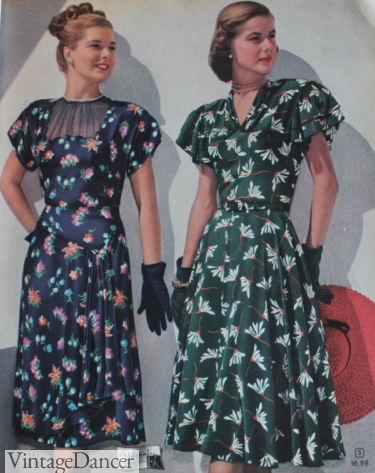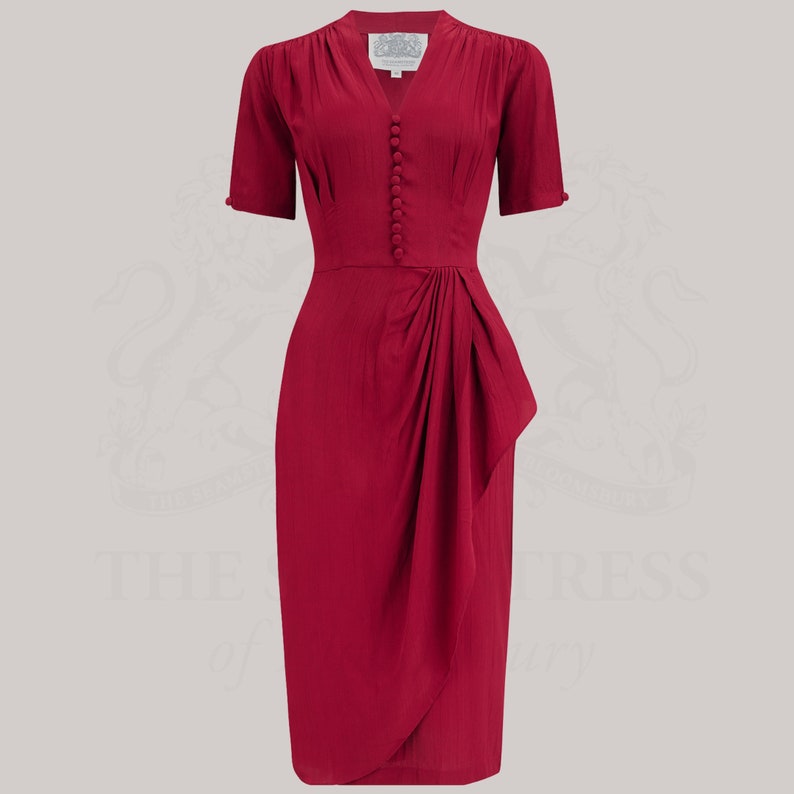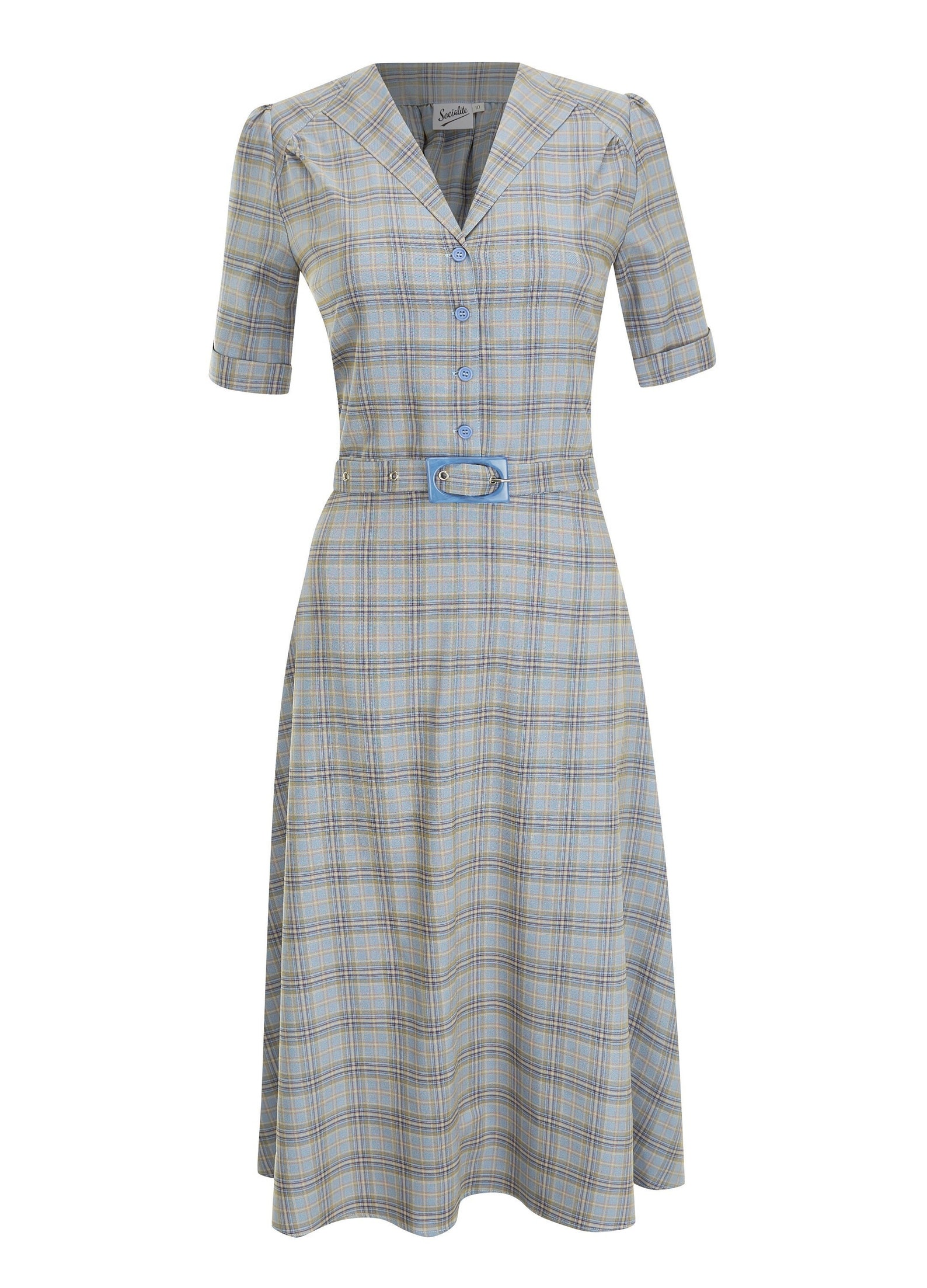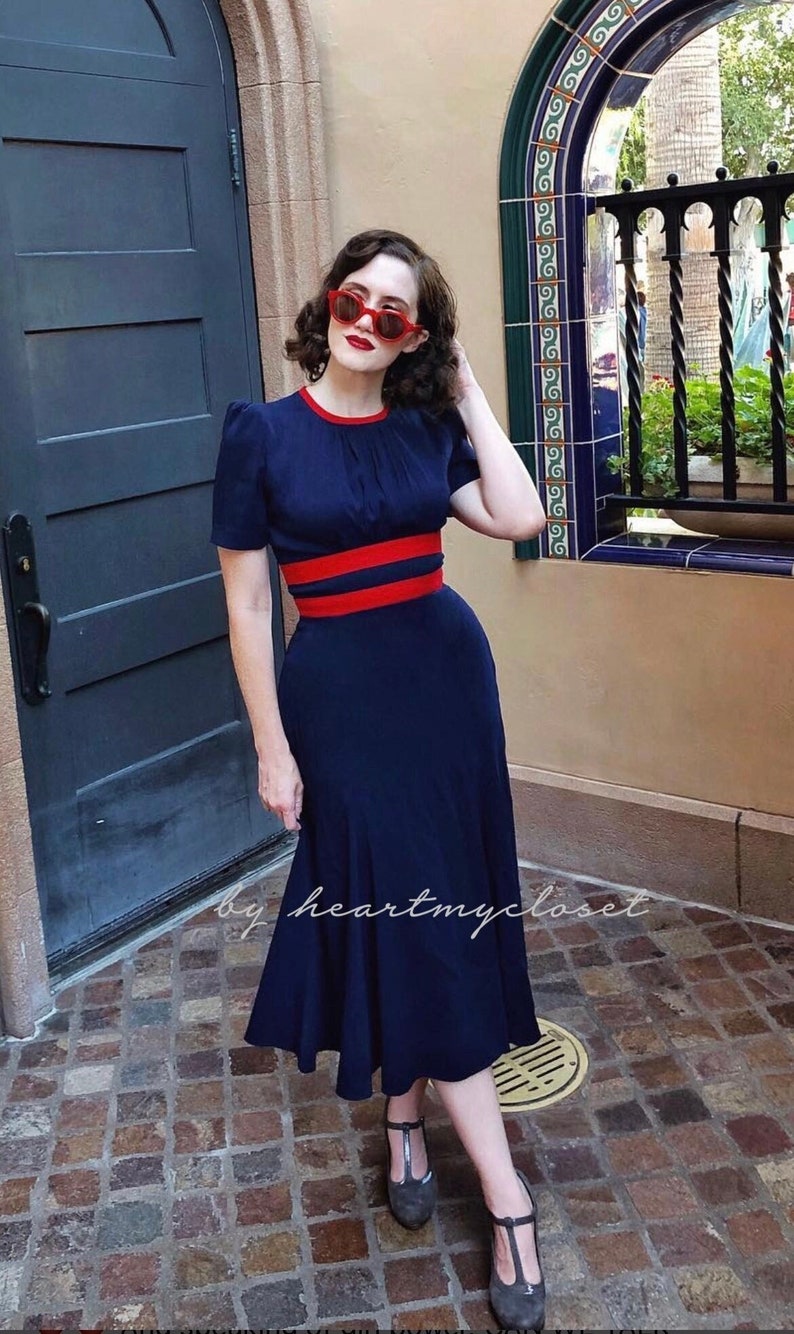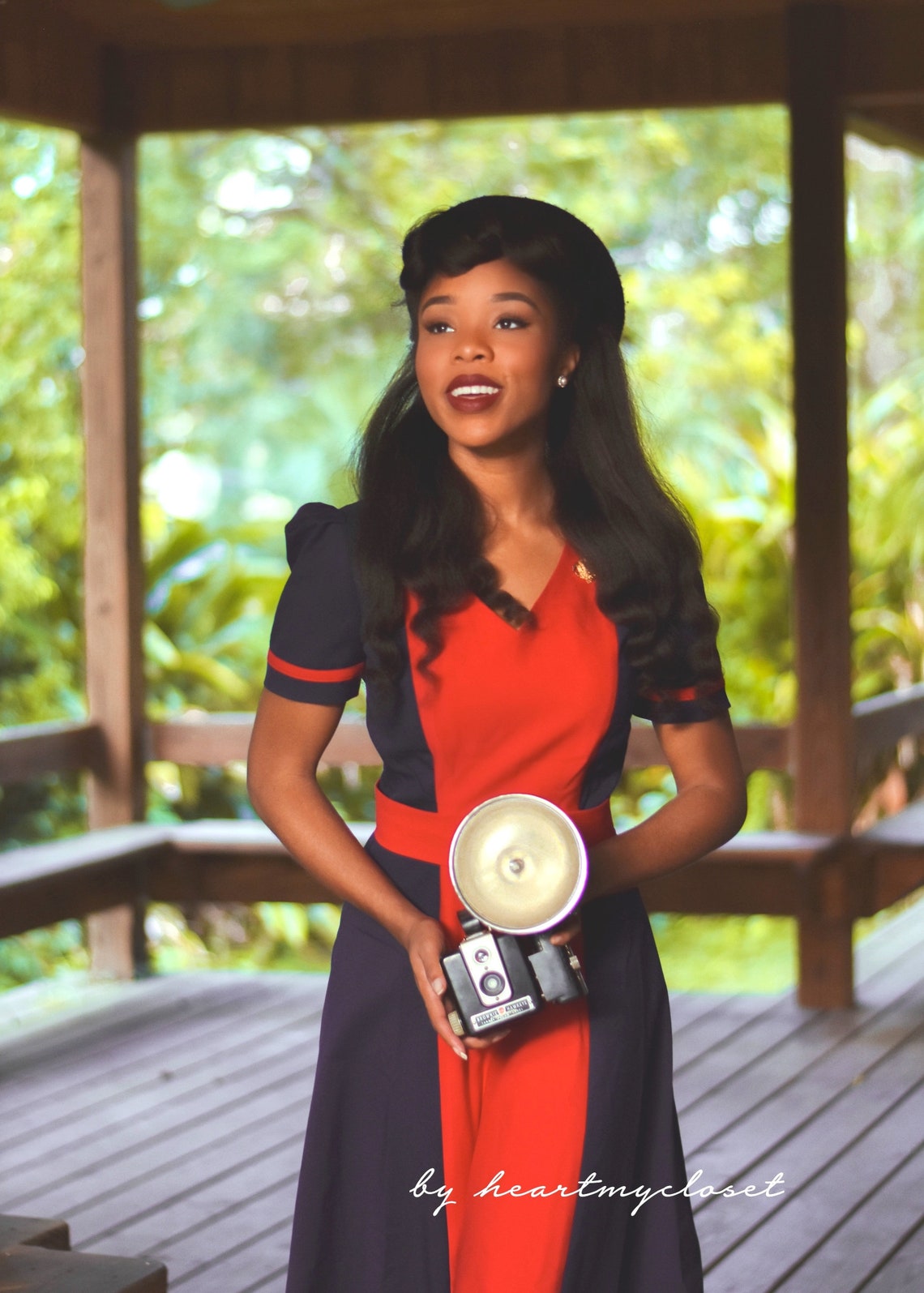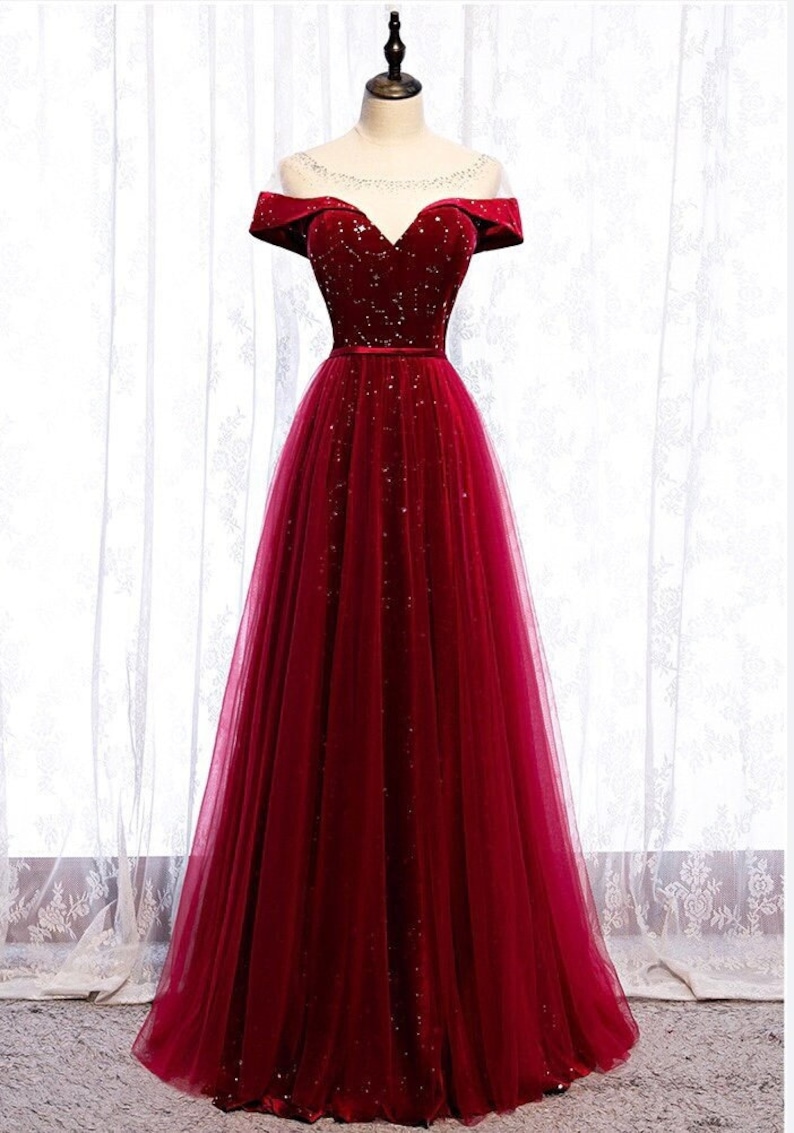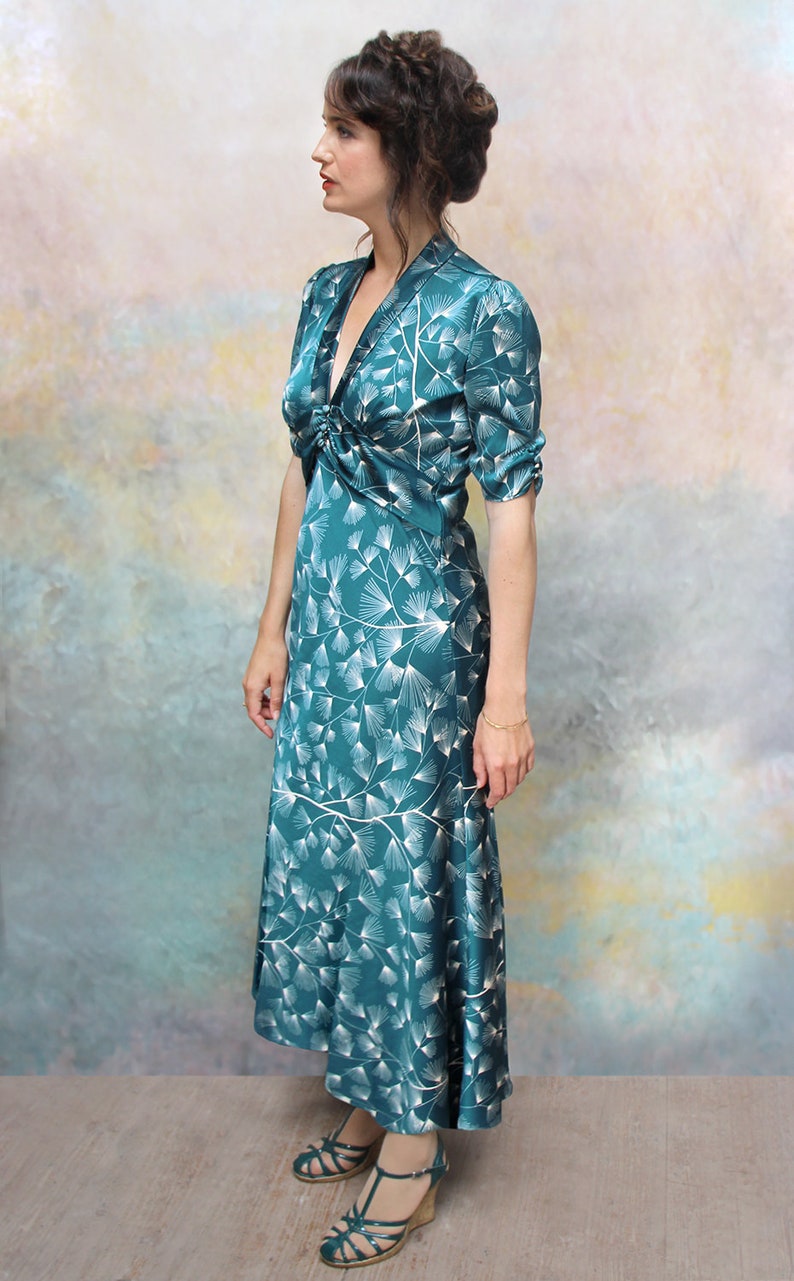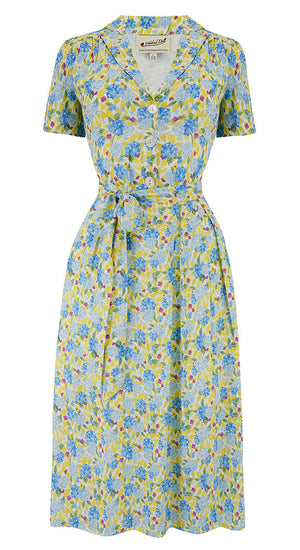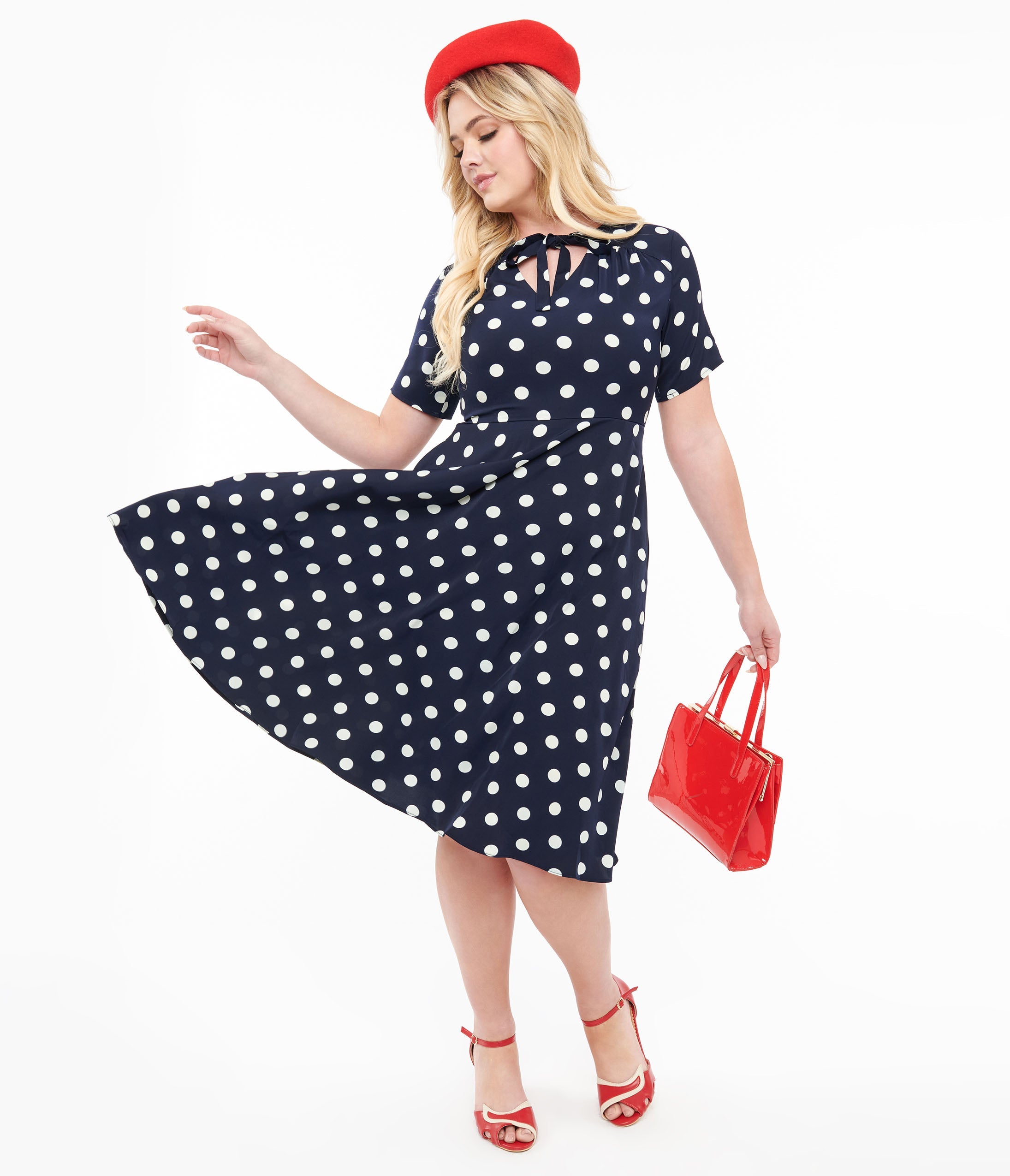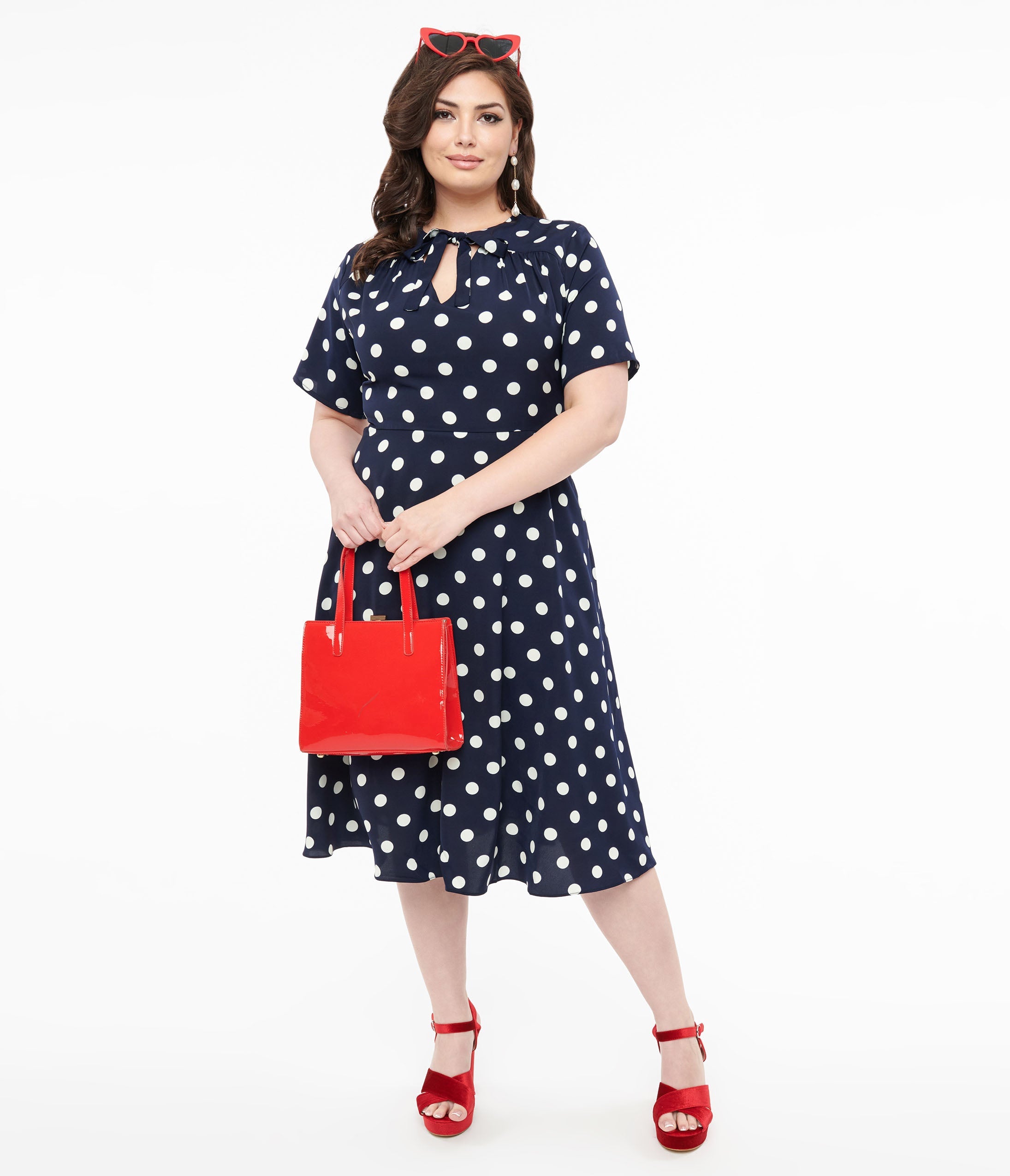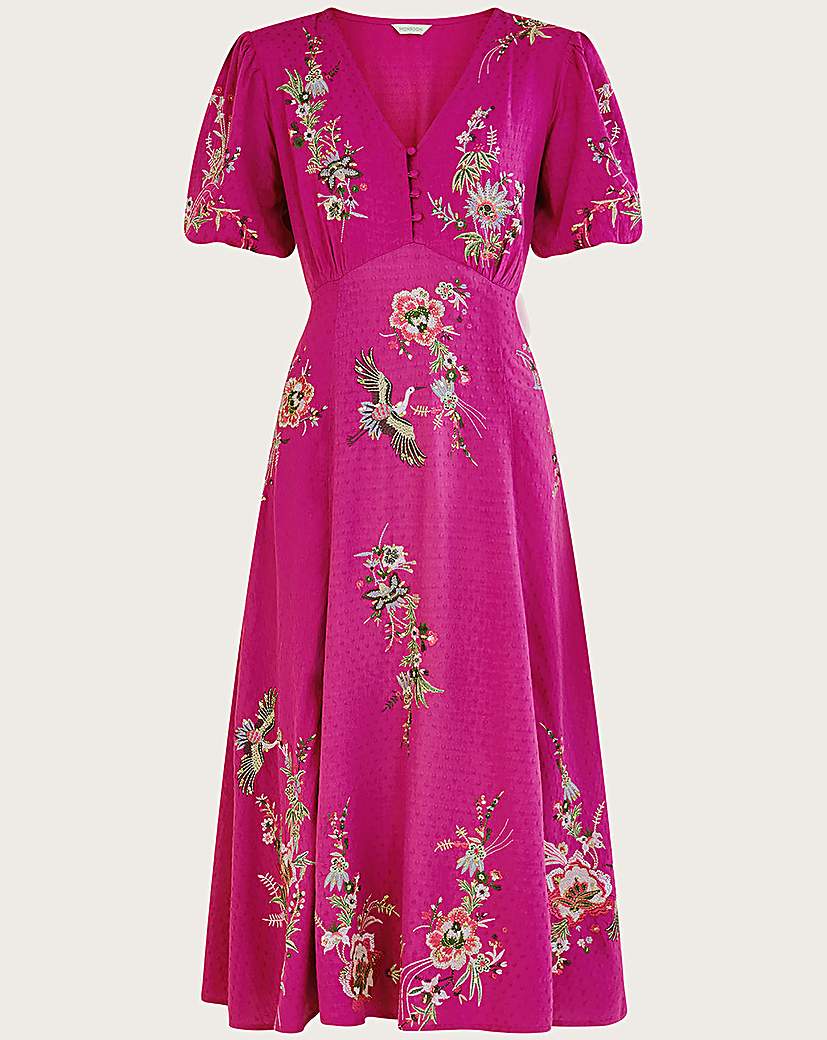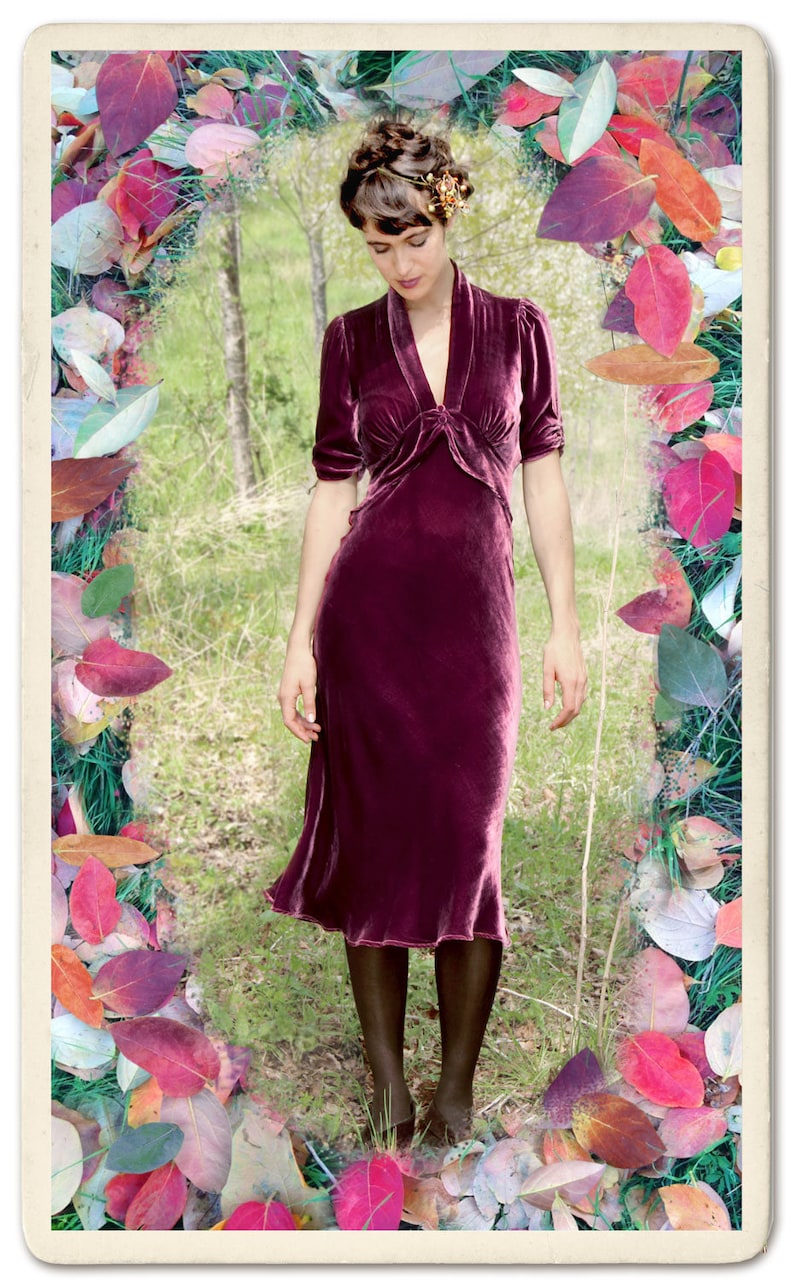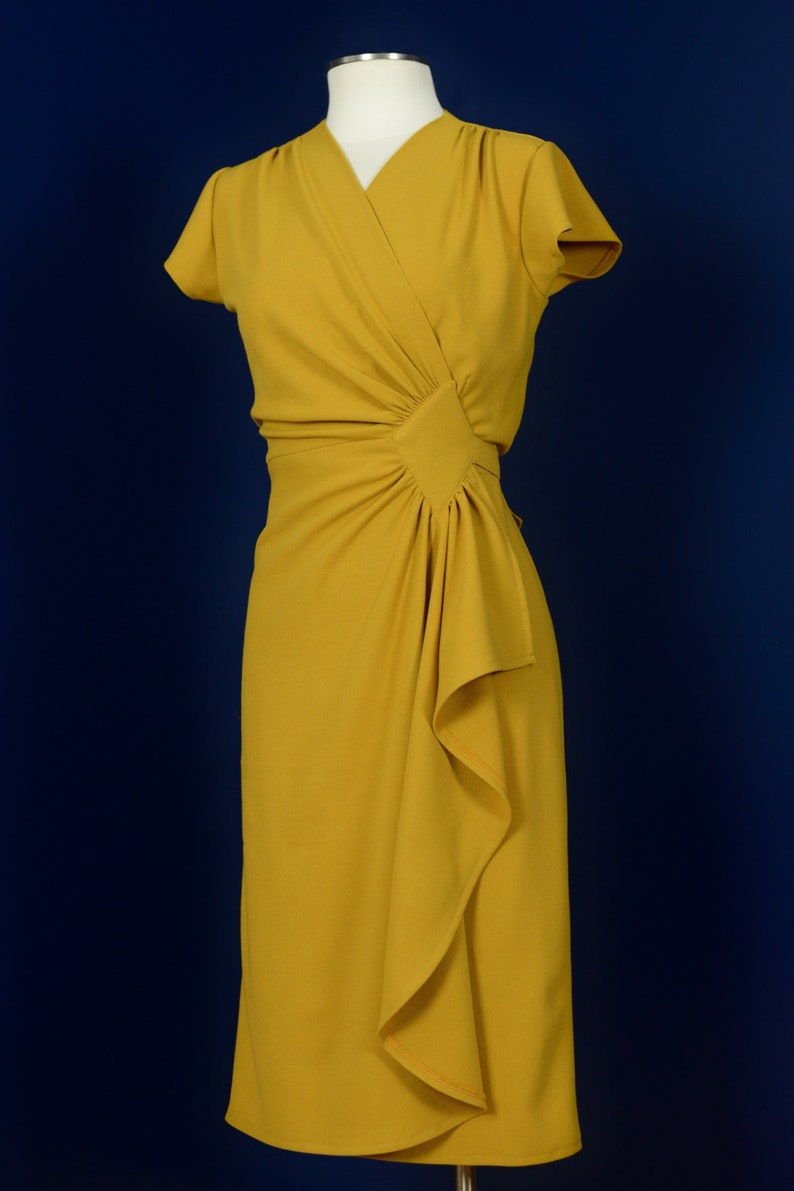My first love of all the vintage retro decades was with the 1940s. Perhaps because clothing was similar to that in the 1980s, the decade I grew up in, and I subconsciously wanted to relive those times? Hmm, maybe. The reason doesn’t matter, but the love for 1940s clothing, especially 1940s dresses, does.
You can skip the history and shop for a 1940s style dress here.
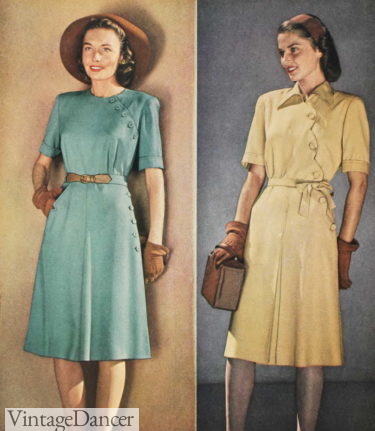
1940 asymmetrical button dresses
At first glance, most 1940s dress styles look alike. Starting in the late 1930s, dresses took on inspiration from menswear. As war approached, women’s roles changed from the ultra feminine to the practical and useful. The bias cut long dress of the ’30s dress required too much fabric. Hemlines shortened to the knee to save on fabric and free women into dresses that were easier to work in. Delicate embellishments were removed, keeping the look economical and simple. Other features were:
- Skirt shapes were A-line. This straight skirt with a little flare at the hemline used very little fabric yet was easy to move in. L-85 allowed for no more than 56 inches of fabric at the hip, 78 inches for the sweep. Pleats, tucks, and shirring were allowed above the waistline but were restricted to using only 10 percent of the material.
- Sleeves were usually short to just above the elbow. The puff sleeve of the early years smoothed out into a deep cap sleeve. Long sleeves gathered at the wrist were an alternative in winter, but not very common.
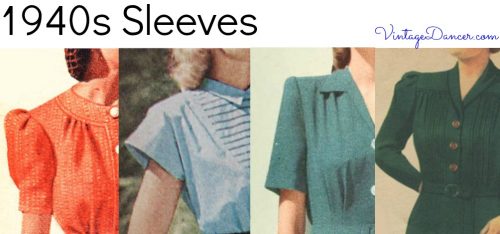
Sleeves: Short Puff, Dolman Cap, Padded Straight, Long Puff
- Shoulder pads extended the shoulder line out past the edge of the natural shoulder. This created a masculine shape.
- Belts were included with almost all dresses. They were usually self-fabric belts that matched the dress material. An alternative was thin leather belts, sash bow ties, or buttons. Nearly all daytime dresses had belts. This was the one feature that gave a dress some hourglass shape and women some of their feminine beauty back.
- Masculine or military-inspired pointed collars and lapels replaced the ’30s round collar.
- Fabrics included cotton, rayon, chambrey, or wool. Sheers, velvet, and silk for afternoon semi-formal attire. Chiffon or shiny rayon for evening.
- Colors were primary tones of navy blue, evergreen, red, violet, pink, medium blue, yellow, brown and black. Learn about popular 1940s colors and fabrics.
There were, of course, variations within these basic rules, especially after the war ended. Most differences were in the dress bodices with several necklines to choose from. Necklines in the ’40s were very high-cut compared to those of today, and would not show even a hint of cleavage.
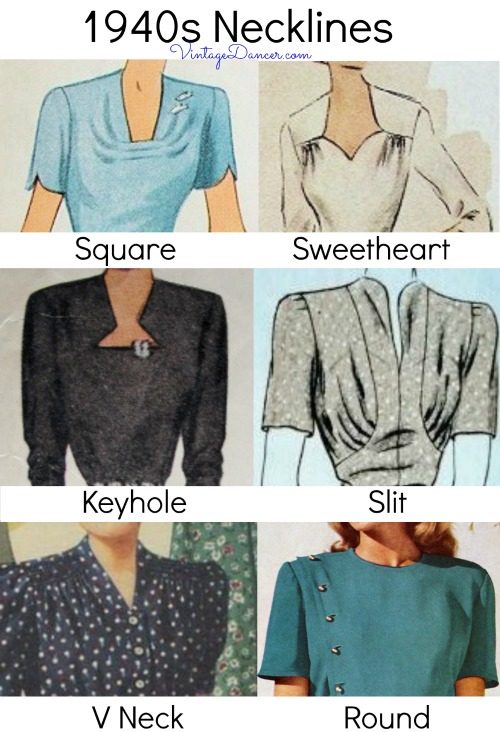
1940s necklines: Square, Sweetheart, Keyhole, Slit, V, and Round.
- The square neckline is pretty self-explanatory – it was square shaped, usually a little bit wider than the neck.
- The sweetheart neckline was about the same width as the square neckline and came to a point. Either side of the point rounded up and then curved out and around the neck. Imagine a heart shape on the front of the dress – the bottom of the neckline is shaped like the top of a heart – the empty space the heart would leave above it.
- The keyhole neckline was fitted around the neck. A small, usually triangle-shaped piece was cut out of the fabric at the neckline, the point facing the top. A thin piece of fabric would be left at the neck, or often a fabric string would tie into a small bow at the neck.
- The slit neckline looked like a very, very thin ‘V,’ maybe an inch or two wide at the top opening.
- V necklines were usually created by the collar and lapels of shirtwaist bodices. Small V necks without collars were also an option. The V never dipped below the collar bones. Very modest!
- The Round neckline could be very high, circling just the neck, to a little larger round neck to expose the collarbone. The latter was a look seen in summer, often embellished with a ruffle trim.
Let us take a look at fifteen 1940s dress styles incorporating these classic elements. These are all day or afternoon dresses. Evening dresses are discussed in a separate article.
1940s Shirtwaist Dress
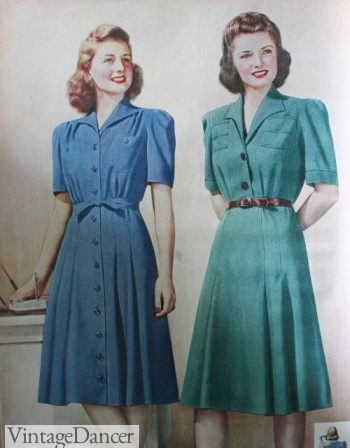
1942 Sears Shirtwaist and Button Down Dresses
The shirtwaist was by far the most common 1940s dress top. Instead of buttoning up the back, shirtwaist dresses slipped over the head and buttoned in the front with rather large (2 inch) buttons. Four to six buttons extended down to the waistline. Buttons could be white plastic or covered in fabric to match the dress. Sometimes shirtwaists had one or two chest pockets if it was a casual style or collarless for afternoon wear.
Little bits of gathers at the shoulder and waist provided some bust shaping. Pintucks across the front also added decorative interest to shirtwaist dress bodices.
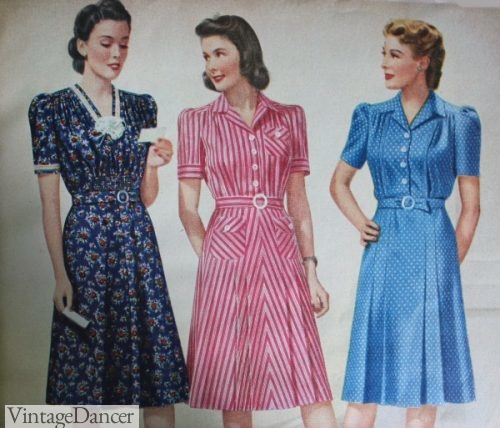
1942 Day dresses, right two are Shirtwaist Styles
The shirtwaist dress was so comfortable, so easy to put on, and so versatile for most occasions that they remained popular throughout the 1950s and well into the 1980s.
Today’s 1940s style fashion seems to favor late 1940s designs and avoid the early ’40s shirtwaist dress. I do see more and more vintage inspired reproduction brands, especially UK brands, carrying more 1940s shirtwaist dresses than a few years ago. The shirtwaist dress is so “40s” that every woman needs to have one. They are my choice dress when puttering about the house or chatting with a friend over coffee. Many shirtwaist styles work well as maternity clothing, too.
You can read even more about and shop for 1940s style shirtwaist dresses here.
- 1942 print and polka dot shirtwaist dresses
- 1948 shirtwaist dresses
1940s Button Down Dress
Similar to the shirtwaist dress was the full button down or button front dress. Talk about easy to put on (other than fastening 10 buttons) the 1940s button down dress was all about casual, comfortable, easygoing style. They were favored by young and mature women alike.
The youngin’s liked them with large round Peter pan collars for a more doll like appearance, while the mature women preferred the traditional shirt collar style. One particularly charming variation of button front dress had scalloped edges. It was one way to make an otherwise informal style a little more fancy in the spring and summer.
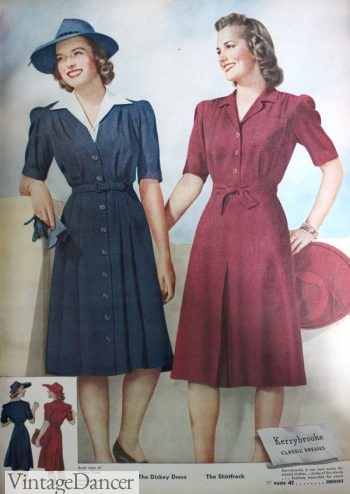
1942 Button Down Dress and Shirtwaist Dress
By the mid forties, buttons didn’t just run down the center front, they were placed asymmetrical or off center (usually the left). Buttons in white or black contrasted against plain dresses, making them pop!
- 1947 chambray blue asymmetrical buttons embroidery dress
- 1949 asymmetrical buttons with draped hip
- 1947 asymmetrical buttons
The shirt front dress was the preferred dress style of the 1940s for simple house dresses or day dresses. Fancier fabrics could be used to make them into tea dresses, but usually did not venture into semi-formal or evening wear.
The best source for new shirtwaist or button down dresses is in — I hate to use this phrase — what we call “Old Lady” clothing stores. The dress styles are timeless and much more 1940s than most contemporary dress fashions. Another source are vintage 1980s dresses. Many ’80s dresses were designed with a 1940s revival look and are still easy to find in the thrift stores. I always recommend beginner ’40s costumers to wear a classic button down or shirtwaist dress. They are ideal for swing dancing, too!
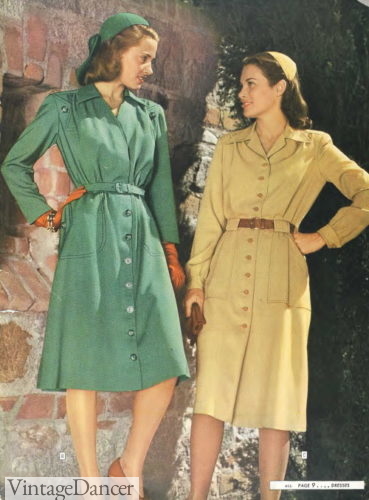
1944 long sleeve button down dresses
1940s Wrap Dress
A common house dress was the cross-front or wrap dress but for daywear they became elegant creations. Fabric would drape from one side to the other and tie in a bow at the front or back. Some wrap fronts were top only styles, while others were full length. They were also ideal for maternity clothing and elderly persons because of the expandable fitting.
- 1945 wrap top dress
- 1945 two peice wrap top dress
To keep in line with the conservative forties, the necklines were rather high, even with a V neck. A hidden snap on the inside of the top wrap snapped to the under wrap so that there would be no “wardrobe malfunction” issues. If modern wrap front dresses had these snaps I would be able to wear more of them.
- 1945 wrap afternoon dress
- 1946 wrap waist cocktail dress
In the late 1940s, the wrap over skirt dress was very popular as a very sophisticated look. With gentle draping and maybe some shirring too, it was flattering and stylish. Also in the mid 1940s, the back wrap dress turned the wrap dress around so the two sides crossed in the back.
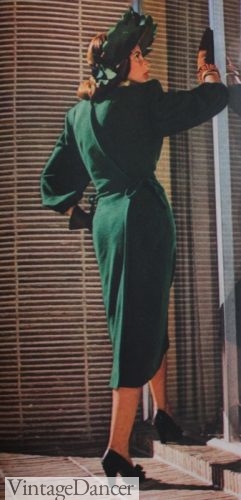
1946 back wrap dress
Most wrap dresses today are made of soft, stretchy jersey (I love jersey), but that also means less structure and less modesty. It is still the style I highly recommend moms to be to wear for a 1940s vintage inspired look. Easy, comfortable, flexible, and flattering.
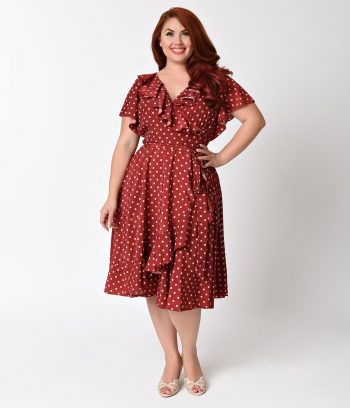
1940s wrap dress at Unique Vintage
1940s Dolman Cap Sleeve Dress
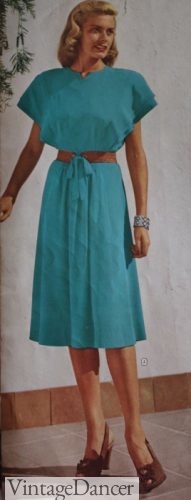
1947 Cap sleeve teal dress
Moving into afternoon dress styles of the mid to late ’40s, we begin to see a new sleeve treatment — the deep cap sleeve. It was a style popular in the 1930s, but when combined with shoulder pads in the 1940s, it took on a new dramatic life.
Cap sleeves are cut in one piece with the dress top instead of sleeves attached separately. It is triangular in appearance, but upside down so the triangle base is along the shoulders and point down to the waist. The shoulder pads extend beyond the natural shoulder giving the sleeve an airy flutter.
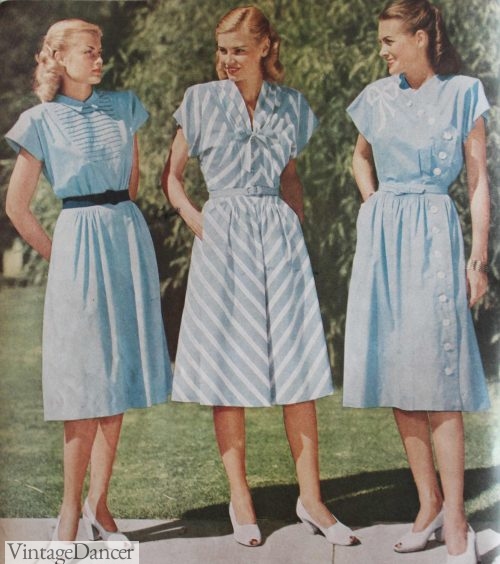
Three dolman sleeve /cap sleeve blue dresses 1947
Most cap sleeve dresses today feature very small caps that have attached sleeves instead of the all in one dolman sleeve. The two looks are quite different. For now, the deep cap sleeves remain a trend left in the past.
1940s Shirred, Ruched, Pintuck Dress
Shirred dresses are amazing! The gathers hide imperfections and give a well-defined waist to those who thought they had none. In the 1940s, shirring and ruching could be minimal or a lot depending on the occasion and materials.
- 1941 ruched shoulders
- 1942 shirring at the shoulders and waistline
A little shirring, vertical pintuck pleats, and gathers above, below, or to the side of the bust added decorative interest as well as the illusion of a fuller chest. A shirred top created a narrow waist, while a full shirred gown was a sleek and sexy style for evening wear. Shirred dresses were magic on whatever part of the body that needed enhancing.
- 1946 pintuck pleated dress
- 1947 shirred waist treatment
Other uses of fabric such as draping, tunic layers, big bows, and small bustles added *more* to 1940s dresses. As the decade moved past the wartime, dresses experimented with more of these layering techniques. At the same times skirt narrow down from the A-line shape to a pencil shape (not curve hugging wiggle, just straight shapes skirts.)
- 1946 ties and draping
- Wrapped skirt dress
- 1947 tunic, wrapped, draped dresses
- 1947 wrap with peplum skirt
Shirred, draped and ruched dresses were more common for late afternoon and cocktail dresses.
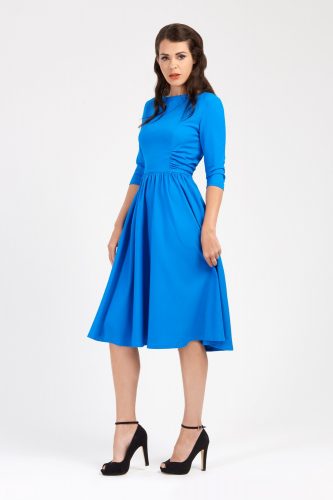
1940s shirred dress at Zoe Vine
1940s Swing Dance Dress
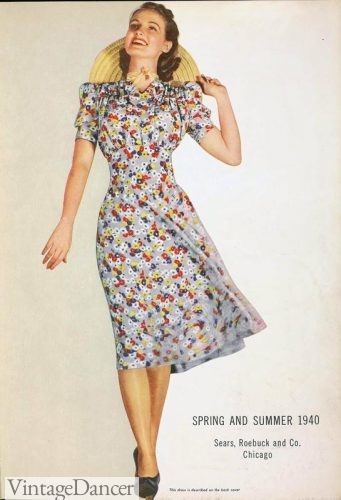
1940s spring floral dancing dress
In the 1940s, dancing was enjoyed by all ages, but it was the youth that enjoyed the most of vigorous swing dancing. To dance freely meant dresses with full skirts and looser arms.
In the early ’40s, A-line skirts were gathered at the top to make them a bit fuller or were wider cut so they swung a little while walking or dancing. After restrictions were lifted, big gathers and more pleats made swing dancing skirts with even more swing.
- 1945 floral shirtwaist dresses
- 1945 summer dresses
In the shoulders, puffy sleeves made arm movements much more flexible. A fitted panel in the middle nipped in the waist, accented the bust, and gave room for a flared skirt.
Surprisingly, modesty was more important to the youth (or maybe it was their parents), with swing dresses having only a little V or square necklines.
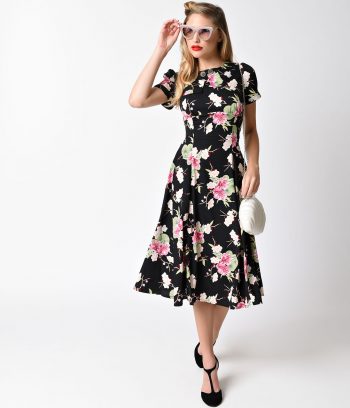
1940s tea dress with lightly puffed sleeves at Unique Vintage
Swing dancing dresses today still have full skirts. They are really fun to twirl in! Lighter materials make them a bit nicer too, in a hot dance room. Many, although not all, swing dresses are in the ’50s style with halter tops or thin spaghetti straps. These certainly are cooler to wear, but personally I don’t like dance partners touching my bare skin, so I choose a modest ’40s look instead.
1940s Sailor / Patriotic Dress
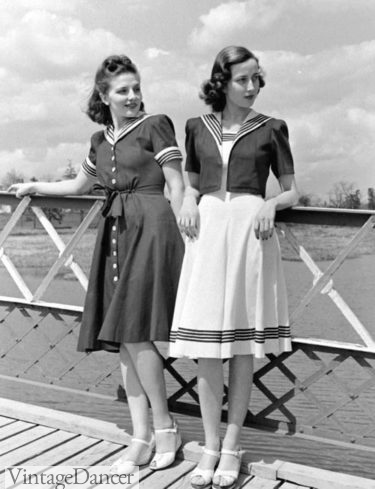
Sailor dresses
The next dress style isn’t just one style of dress, but a popular color combination of navy blue and white. These nautical or sailor inspired designs were favorites in summer time. Usually dresses were all blue with buttons and white striped around the hem, collar and arm cuffs. This sailor theme was worn with skirts, pants, playsuits, shorts and swimsuits too.
Many 1940s dresses also had blue and red or red and white color combinations as well. These patriotic colors showed a woman’s support for her country.
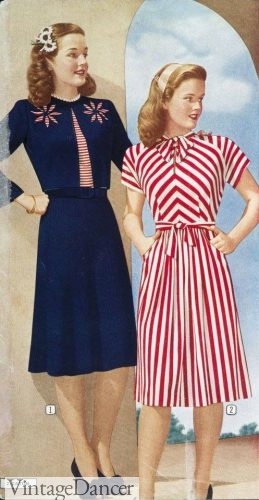
1945 blue, red and white themed dresses.
Today’s sailor inspired dresses really bring out the patriotic or nautical vibes. They are a perfect style for WWII memorial events and national holidays. In a slim fitting pin up dress style, they are also common for WWII themed performing groups. Eh hem, Andrews Sisters.
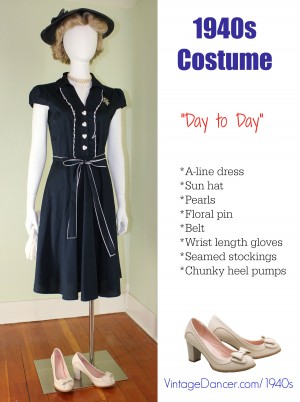
1940s Costume with “About the Artist Dress” at Modcloth
1940s Border Print Dresses
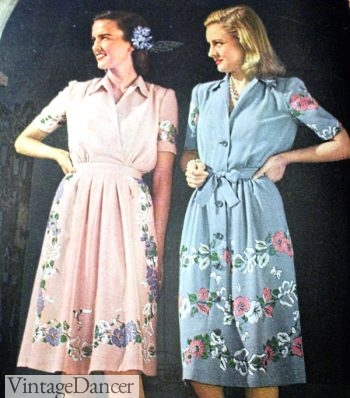
1940s spring dresses with floral border prints
While all over prints were the most common dress pattern, there was a brief interest in the mid 1940s for border prints dresses. Prints on these dresses were usually large florals that danced along the lower 1/3 of a dress skirt and around sleeves. It was a cheerful look for spring time.
While the trend didn’t last more than a year or two it was a style that was to come back strong in the 1950s.
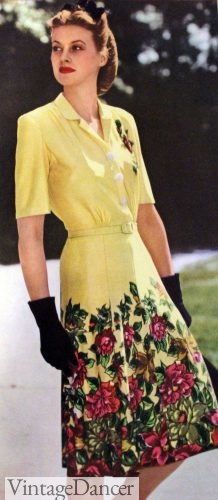
1944 border print yellow dress
1940s Peasant Dress
The peasant look was very popular in mid 1940s summer time, especially with teenagers. The peasant blouse and dirndl skirt (also called an Alpine skirt) were by far the cutest and most comfortable outfit to wear for both young girls and women. The skirt had a gathered waistband and was usually a fun print, stripe or check with a one or more wide ruffles along the bottom. These ruffles were often trimmed in white lace or rickrack.
- 1945 teen girl’s peasant dresses
- 1948 Peasant Dresses
The dress top had a gathered neckline and puffy sleeves or elastic gathered crop sleeves. While technically the dirndl is a skirt, peasant dresses connected a matching skirt and top together creating a dirndl dress. These often came in a folksy front lacing corset tops too.
Other peasant style included large prints such as the flowers and strawberries on the right paired with a ruffle trimmed or embroidered blouse. Other styles were simple plain dresses trimmed in white lace. You can thank Carmen Miranda for make this fad explode in the late 1940s.
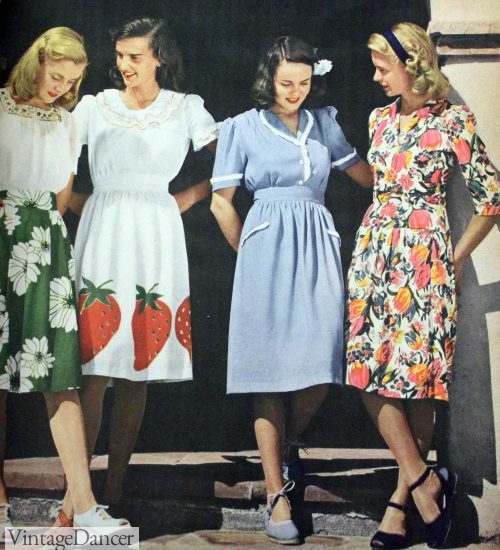
1947 folk print peasant dresses
The peasant style was renamed the Gibson Girl around 1947. Ruffle trimmed blouses, long full skirts, contrast trimming, bow neckties, and dramatic sleeves gave a nod back to the Edwardian era (which is also back in style now.)
- 1948 Gibson Girl style plaid dresses
- 1948 Gibson Girl style dress, skirts and blouse
The peasant dress remains a summer time staple in both vintage and modern circles. The dirndl skirt comes and goes in high fashion, but because of how easy they are to make, they are a frequent style among vintage home sewers. Store bought dirndls usually replace the ruffle with a ribbon stripe for a less “folk” look. Which style do you prefer?
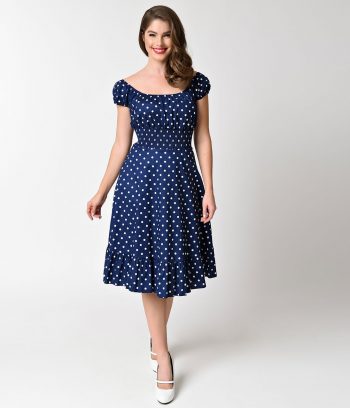
1940s peasant dress at Unique Vintage
1940s Apron Pinafore or Jumper Dress
A similar dress to the dirndl dress was the pinafore dress. Pinafore or jumper dresses have an apron like bib with straps over the shoulders and is crossed in the back. In the 1940s, the straps were often ruffled, giving the dress an even more vintage apron look. These dresses often had two large patch pockets as well.
- 1944 apron style summer dress
- 1944 pinafore apron gingham dress
The apron dress could be sleeveless or worn over a blouse. It is a nod to the school girl “pinafore” uniform, and as such was usually worn by teens and young girls. Today, I see a lot of young women (but not teens) wearing jumper dresses, and they look so fun!
- 1944 teen pinafore dresses
- 1944 apron pinafore dresses
For non-teens, there was a dress that incorporated the apron’s large pockets into a design more fitting of mature women. I call them the pocket dresses. Large, oversized pockets patched onto the front sides of common day dresses (shirtwaist, peasant, apron, swing).
- 1947 jumper dresses over white blouses
- 1942 red wool jumper dress over yellow blouse
1940s Sheer Dresses
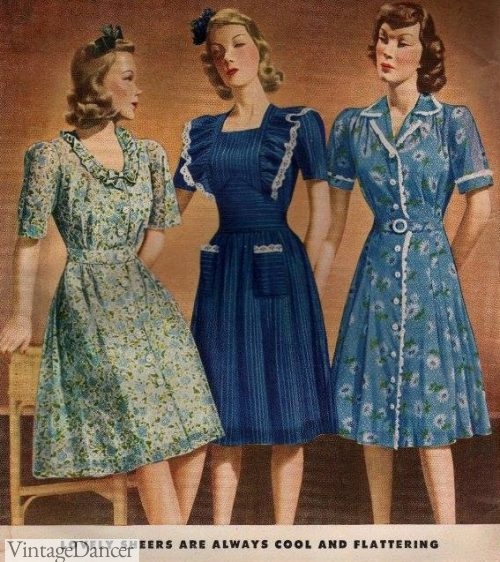
1940s semi-sheer dresses
While modesty was important in the 1940s, sheer dresses for Spring were a welcome relief on warm days. Sheer fabrics were also a bit nicer looking, making them appropriate for having brunch with friends or going to a Sunday afternoon tea dance.
Sheer dresses were not see through. The fabric was light, but lined with a thicker solid color. Often, the sleeves and some of the upper chest area were the only parts that were unlined.
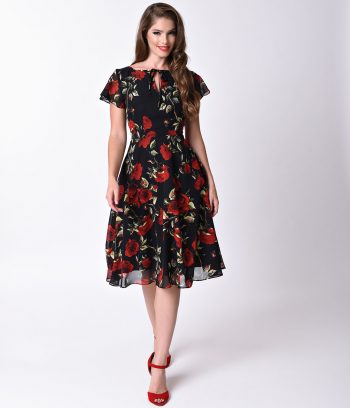
1940s sheer dress at Unique Vintage
1940s Peplum Dress
The peplum dress had a heyday in the ’40s and again in the ’80s. A peplum was basically an extra long top that hung down to the hips and over an attached skirt. It looked best on late ’40s dresses with thinner straight skirts and in semi formal styles. They were frequently a part of 1940s ladies’ suits, too. The extra volume at the hips made the waist look smaller, and what woman doesn’t love that?
- 1945 teen ruffle trim peplum dress (R)
- 1946 suit style peplum dress
Today’s peplum dresses are almost always part of a very slim fitting pencil dress. Some of have tiny peplums, while the vintage inspired styles stay true to a longer peplum. Despite the waist slimming effect, they don’t look good on everyone (like me), so it is best to try a modern one on in person before venturing online for the better vintage styles.
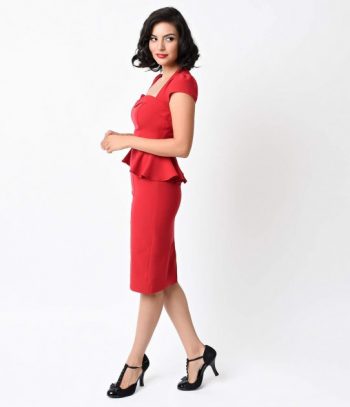
1940s peplum dress at Unique Vintage
There were other two piece dresses besides the peplum dress. The tunic dress had a longer peplum, the suit dress was a short sleeve blazer and skirt combination, and the bolero jacket and skirt worn over a blouse created a third option.
- 1945 two peice suit style day dresses
- 1948 bolero jacket and skirt or peplum top two peice sets
1940s Pin Up Dress
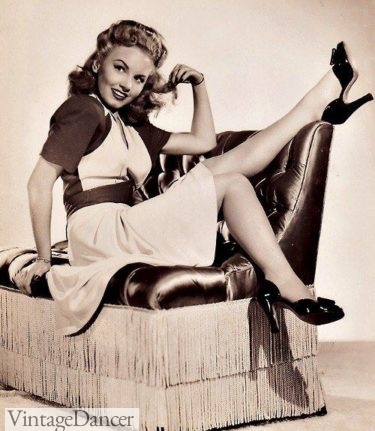
Oh, 1940s pinup dresses, how do I love thee! While a tight pencil shape wasn’t exactly true to the 1940s, the overall style and feel of the pinup wiggle dresses is certainly vintage and sexy in an “I can wear this anywhere and feel amazing” kind of way. It is also one of those miracle dresses that make curvy women actually love their curves. Yeah! They are hot stuff, and husbands/boyfriends love them too.
What makes a 1940s dress a pinup dress? Lower bustline, tighter fit, shorter sleeves (cap sleeves are common). Red, black, and navy blue are all popular colors for pinups.
1940s Party Dresses
There was little need for fancy evening gowns and party attire in the 1940s. Women usually wore their nicest afternoon dresses to a dinner party or night out. The ruched dress, sheer dress, and wrap dresses mentioned already translated the best into partywear. The shirtwaist dress was too much of a daytime look for evenings but there were some exceptions.
Black cocktail dresses were, by far, the most charming. Other dark colors such as deep green, navy blue, purple and sometimes pink were also worn in the evenings. Solid colors rather than prints, embellished with beading, embroidery, sheer insets, and lace added a bit more bling to otherwise plain dresses.
Learn more about party dresses and evening gowns.
- 1946 suit, and dresses for afternoon and evening attire
- 1948 navy blue lace trim afternoon and party dresses
- 1945 Small V neck party dress
- 1948 print dresses in silk made lovely party dresses
More 1940s Dress Articles
1940s House Dresses, Home Frocks
1940s Plus Size Clothing: Dresses History
1940s Formal Dresses, Evening Gowns History
1940s Fabrics and Colors in Fashion
1940s Outfit Ideas– How to DIY 1940s outfits with dresses, accessories, shoes and more
